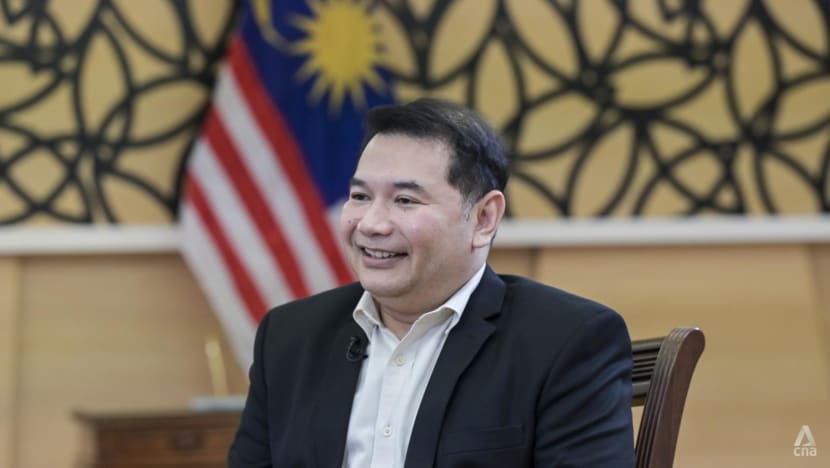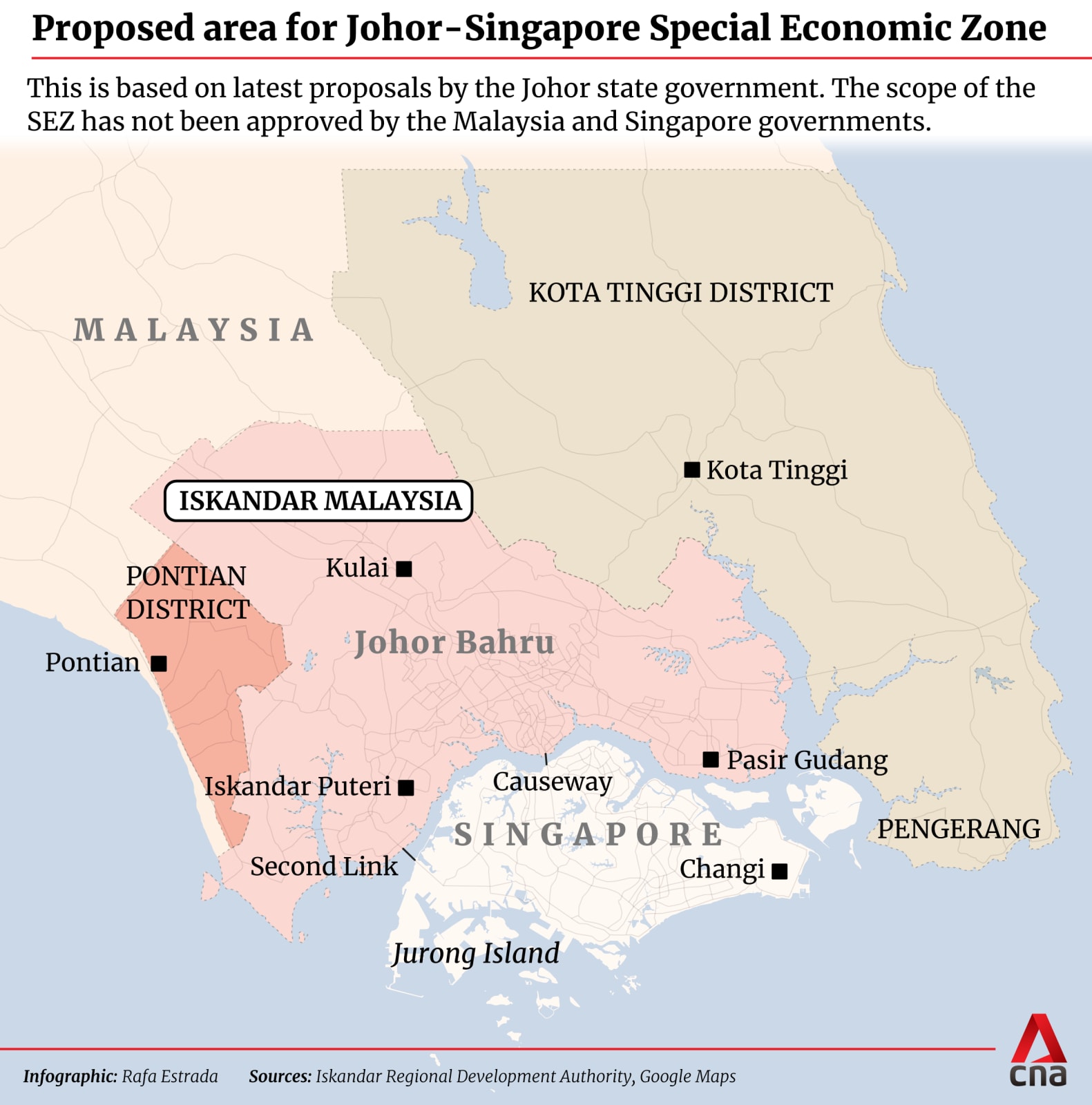Q&A with Malaysian Economy Minister Rafizi Ramli on Johor-Singapore Special Economic Zone
In an interview with CNA, he shares the rationale behind some decisions regarding the Johor-Singapore Special Economic Zone and how the project aligns with his country’s vision.

Minister of Economy Malaysia, Rafizi Ramli during an interview with CNA TV on January 3rd, 2025 in Putrajaya. (Photo: CNA/Fadza Ishak)

This audio is generated by an AI tool.
PUTRAJAYA: The Johor-Singapore Special Economic Zone (JS-SEZ) is set to strengthen bilateral ties, and eventually elevate the Association of Southeast Asian Nations (ASEAN) as a global investment hub.
This was affirmed by both Singapore and Malaysian governments during the 11th Malaysia-Singapore Leaders’ Retreat in Putrajaya on Tuesday (Jan 7).
In an exclusive interview with CNA's Afifah Ariffin last Friday, Malaysian Economy Minister Rafizi Ramli shared the benefits of the zone, how ASEAN will factor into it, and why the project will continue regardless of a change in leaders.
Q: We know that the economies of Johor and Singapore have always been very highly interdependent. Many Singaporean companies are already existing in Johor in some capacity. But what is the motivation then for formalising it to become a Special Economic Zone now?
We are at a good (juncture) now where we can jointly promote and develop Johor and Singapore as one of the top global investment destinations. Singapore has been getting the kind of investments that had developed Singapore so far, Malaysia - and Johor - has had the kind of investments we rely on in the past, but for us to move to the next tier, especially in Malaysia's case, to move to the next tier of high value high tech investments, we have limitations.
Likewise … to sustain and continue to grow, Singapore also has limitations. So the sum of … Singapore and Johor is actually a lot more than the individual sum of Singapore on its own or Johor on its own, especially in the context of making it as a global investment destination, taking into account the developments happening around us.
A lot of global corporations are looking at ways to manage the trade wars … and we feel that putting it (JS-SEZ) together when investors can have the best of both worlds - they can tap into the resources and potential of Johor, yet having access and also benefit from the sophistication of Singapore - I think that's a very good value proposition to the world.
Q: How does this Johor-Singapore Special Economic Zone align with the broader economic goals of the Madani government?
First is the need for us to cross the line to become a high-income nation. We are expected to become a high income nation between 2028 (and) 2029 but for this to happen, we really need to accelerate the restructuring of our economy, moving away from one that is based on commodities and manufacturing to one that creates value and IPs (Intellectual Properties).
And for this to happen, we do need an infusion of a new wave of high tech investments. We have a good base in Penang. We have a good base in Klang Valley, but Johor is very suitable for that next engine of growth for this kind of investments. But we realise that perhaps we could do this so much better working with Singapore.

Q: The SEZ spans about nine flagship zones, targets diverse sectors, from R&D, manufacturing, energy. Why was the decision made to adopt such a broad, multi-sectoral approach instead of being more specific?
We want to take into account the fact that ASEAN is expected to be the fourth or third largest economy in the world in the next 10 (or) 15 years. And therefore, this is going to be not just a manufacturing hub for the world, it is also going to be a very strong consumer market for the world.
If we were to just confine it to two or three industries, we may lose out, especially if the interest from the investors is a lot wider than that. So these sectors, including these nine nodes, are basically sectors and geographical locations with already existing base and strength … We just need to infuse and scale up newer investments into it to reach some kind of critical mass. And for that, I think it’s better to pay close attention to what drives the investments rather than what we think the investment should be.
Q: About investors, what incentive is there for them? Because you earlier talked about how there are joint promotions, a shared blueprint to create synergies, but there are still separate financial, fiscal incentives from both sides. What's in it for investors?
The biggest value proposition is that synergy, is that potential, and then we build everything around it. And that's why the focus on easing the flow of people, the movement of goods, and then harmonising processes, and then making sure that talents are ready - that I feel is a lot more valuable to investors than purely from a fiscal perspective.
Of course, if I were an investor, my concern to go, especially into a greenfield industrial area in JS-SEZ, is the readiness of infrastructure. So that's why Malaysia has put aside an infrastructure fund and works with investors, cluster by cluster to make sure that the infrastructure development can happen hand in hand as they develop their business here, as opposed to existing methods in Malaysia, whereby it's very sequential.
We decided to pave the way by building infrastructure first, and then the gestation will come in, and it takes a long time, and you have a situation where investors might want to go into an area, but the infrastructure is not ready.
They have to go through various agencies and ministries in order to get the approval for those infrastructure. Everything is now fast tracked because it's built into JS-SEZ. So I think the combination of all this (and) not necessarily just a fiscal incentive in the traditional sense is … what we hope will get a good approval from investors.
Q: Given Johor's close proximity and its interdependence on Singapore, is there a concern that there will be over-reliance on Singapore companies investing in this SEZ? What is the plan to sort of attract companies from the region, from global MNCs?
I've always maintained consistently in all the discussions about JS-SEZ that it would be such a big loss if JS-SEZ just looked at Singapore and Malaysia. So likewise, when it comes to investments, our view is that JS-SEZ is going to be very attractive to global investors.
It's just that if I were a global investor now looking to expand and having a foothold into ASEAN, I have a few options. I can go to Vietnam, I can go to Indonesia, I can go to Malaysia, or say Singapore. But then again, if I were to go to Singapore, Singapore has its plus point, but it also has its limitations, and vice versa for Johor. And therefore, the synergy that we can offer is designed to attract global investments, and that by itself, I think, will be able to manage this concern of over-reliance on Singapore businesses.
The spillover obviously will benefit both Malaysian and Singapore companies, because Singapore companies now have a much better ecosystem for expansion if we achieve the critical mass, which is driven by global investments into JS-SEZ.
Q: The vision for this SEZ is to rival some of the successful zones in countries like China, United States, Germany, but we know that those are very different from what we have here, where it requires two different countries, different jurisdictions. What would it take then to be on par with some of these successful zones?
I remain optimistic that ASEAN will grow, and then common sense will prevail in this region that we are much stronger as an economy of 700 million plus people, if we become more integrated.
This ambitious JS-SEZ, special economic zone between two countries, which is not common in this world, is a manifestation of the first few steps towards a closer integration between two ASEAN economies, and I hope that it paved the way for more integration at the ASEAN region, because if we are able to do this, then we have better chance to realise ASEAN potential of this large market.
So therefore, while it is very different, and therefore it has a set of challenges, it also addresses that necessity to push for more integration between economies in ASEAN. So let's start with Johor and Singapore, and I hope that if it works, it strengthens the case for more integration beyond Malaysia and Singapore in ASEAN, because we really need to pool our resources and see how do we work together to play to our respective strengths in the future.
Q: So with this agreement now signed, what are the immediate next steps to bring this SEZ to life?
There'll be a series of work streams that have to happen in parallel. At the planning level between Malaysia and Singapore, there will be a high level committee that starts working on the blueprint, because it’s a chicken and egg (situation). We can't do a blueprint until we iron out the principles. So now that, with the agreement, all principles and commitments and shared vision are sealed, then we can move to the next step, which is to develop the blueprint. And with the blueprint, it will make it a lot easier for joint promotion between Malaysia and Singapore agencies, while at the same time all the administrative infrastructure to facilitate the first wave of investments, I think are already there.
On Malaysia's part, we already have the Iskandar Malaysia Facilitation Centre, where we pull all the government authorities into one roof to expedite bureaucratic processes so that investments can be processed much quicker. And in terms of the governing infrastructure, it's already been built into the agreement. And then we just need to hit the ground running after this. So I think (in) 2025, we will see more physical details of what is the vision for each node.
Q: Some sceptics are also saying a concern is politically proofing the SEZ. What steps are being taken to ensure the long term success of this project?
Value. There's always this concern that if there is a change of leadership or government or even a different minister, then what can happen to something as ambitious as JS-SEZ. I take comfort from this one truth which is this is not driven as a personal or administrative project.
This is a response to a commercial common sense, and the proof of the pudding is to make sure that it realigns its commercial potentials, and we are able to get that committed 50 projects in the first five years off the ground. And I think once we are able to demonstrate that, then we will be able to convince more and more investors who already understand basically the theoretical synergy and value offering of such an economic zone between Johor and Singapore, but want to see how this is going to take off. If we are able to pull off the first 50 projects that are committed in the agreement … then I think it will work by itself.
Q: We’re seeing 50 projects in five years, possibly 100 projects in 10 years … What is your vision for this - JS-SEZ, in the next one decade, two decades, what do you see it to be?
I would like to see an economic zone that is no longer defined by Malaysia or Singapore, or is no longer limited by what we think are our respective constraints, but one that can really compete at the global level for the highest level of innovation and technical complexity. And if this were mooted 20 years ago, it would have been a lot more difficult, because at that time, even if we are able to crowd in such investments … the market for these products and innovations would have to be elsewhere, would have to be in Europe, would have to be in the US, perhaps the Far East.
But we have that advantage now, where, in 10 to 15 years’ time, ASEAN is expected to be a very prosperous and middle-class economy. So I'm hoping that when that comes together, you have the JS-SEZ as a centre of that innovation and consumer market economy that serves not just the world, but also serving by and large, ASEAN as well.
















